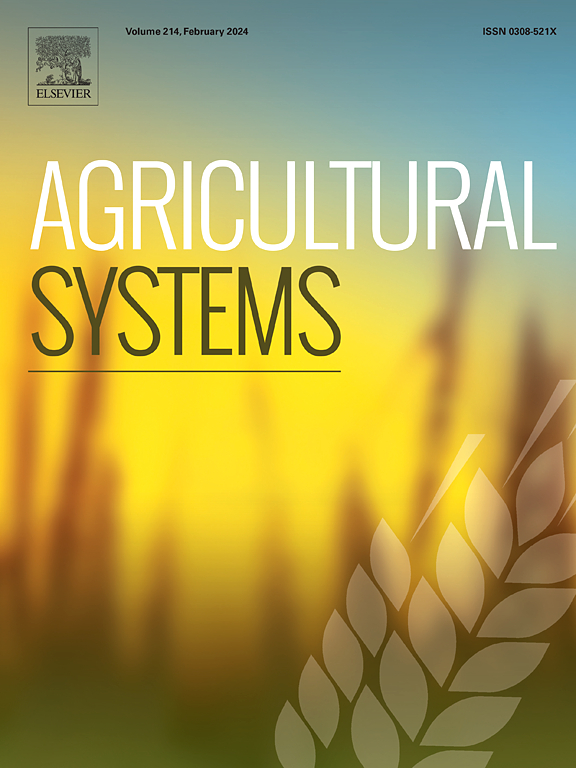气候友好型泥炭地管理的减排成本——德国两个泥炭地农业利用地区的案例研究结果
IF 6.1
1区 农林科学
Q1 AGRICULTURE, MULTIDISCIPLINARY
引用次数: 0
摘要
背景在德国,为农业而排水的泥炭地每年造成超过 4000 万吨二氧化碳当量的排放,占所有农业排放的 44%。由于泥炭地具有很高的减排潜力,它们在欧盟农业政策和德国国家减排努力中的重要性与日俱增。我们的工作研究了农场在提高水位(湿利用)的情况下扩大其排水草地或在完全复湿的情况下放弃传统土地利用时如何适应。我们还计算了适应策略的收入变化和减排成本。方法为了模拟连续的土地用途转换,我们应用了一个线性规划的农场级模型。数据基于对德国两个泥炭地地区典型农场经理的访谈,这两个地区的农业结构迥然不同:第一个是石勒苏益格-荷尔斯泰因州的艾德-特雷内-索尔格低地,农场(直径 150 公顷)主要以草地为主;第二个是勃兰登堡州的莱茵-哈维尔鲁赫,主要是大型(直径 2000 公顷)混合农场。这些农场代表了集约、适度和广泛使用草地的梯度。此外,我们还对草地进行了监测,以估计不同水位和草地使用强度下的饲料质量。这包括饲料数量和质量的损失及其后果,如牛存栏量减少。主要的适应策略是强化剩余草地和增加饲喂可耕饲料。相关的边际农场收入损失以影子价格曲线表示,变化很大。它们取决于农场结构变量(农场类型、适应潜力),有时非常陡峭,特别是在半密集型农场,即大部分草地的收入损失较低(最高 500 欧元/公顷),而最后几公顷的损失则特别高(数千欧元)。相应的边际温室气体减排成本也有很大差异,但主要低于 55 欧元/吨二氧化碳当量。 研究结果进一步表明,大面积湿润比完全复湿造成的减排成本更高。研究结果表明,不同类型的农场有适当的补偿率,可用于限制对受影响农场的影响,如通过土地合并避免高收入损失。本文章由计算机程序翻译,如有差异,请以英文原文为准。

Abatement costs of climate-friendly peatland management – Case study results for two German peatland regions under agricultural use
CONTEXT
In Germany, peatlands drained for agriculture cause more than 40 Mio. t CO2 equiv. per year, which accounts for 44 % of all agricultural emissions. Because of their high mitigation potential, they are becoming increasingly important for EU agricultural policy and Germany's national mitigation efforts.
OBJECTIVE
Our work investigates how farms can adapt when they either extensify their drained grasslands with raised water levels (wet use) or abandon conventional land use under full rewetting. We also calculate income changes and abatement costs of adaptation strategies.
METHODS
To simulate successive land use conversions, we applied a linear programming farm-level model. The data are based on interviews with managers of typical farms in two German peatland regions with very different agricultural structures: the first, the Eider-Treene-Sorge lowlands in Schleswig-Holstein, with farms (Ø 150 ha) that are predominantly grassland based, and the second, the Rhin-Havelluch in Brandenburg, with mainly large (Ø 2000 ha) mixed farms. The farms represent a gradient of intensively, moderately and extensively used grassland. In addition, we carried out grassland monitoring to estimate forage quality at different water levels and intensities of grassland use.
RESULTS AND CONCLUSIONS
The results show the farm-level effects of increasing land use conversion on the grasslands of the six model farms. This includes the loss of fodder quantity and quality and its consequences, such as a reduction in cattle stock. The main adaptation strategies are intensification of the remaining grassland and increased feeding of arable forage. The associated marginal farm income losses are expressed in shadow price curves that vary greatly. They depend on farm structural variables (farm type, adaptation potential) and are sometimes very steep, especially in semi-intensive farms, i. e. for a large proportion of the grassland, income losses are low (up to 500 €/ha) while the last hectares incur exceptionally high losses (several thousand euros). The corresponding marginal greenhouse gas abatement costs also exhibit a wide range but are mainly below 55 €/t CO2 equiv. The findings further show that extensive wet use causes higher abatement costs than full rewetting.
SIGNIFICANCE
Patterns of the shadow price and abatement cost curves are transferable to comparable farms. Findings indicate adequate compensation rates for different farm types and can be used to limit the impact on the affected farms, e. g. avoidance of high income losses by land consolidation.
求助全文
通过发布文献求助,成功后即可免费获取论文全文。
去求助
来源期刊

Agricultural Systems
农林科学-农业综合
CiteScore
13.30
自引率
7.60%
发文量
174
审稿时长
30 days
期刊介绍:
Agricultural Systems is an international journal that deals with interactions - among the components of agricultural systems, among hierarchical levels of agricultural systems, between agricultural and other land use systems, and between agricultural systems and their natural, social and economic environments.
The scope includes the development and application of systems analysis methodologies in the following areas:
Systems approaches in the sustainable intensification of agriculture; pathways for sustainable intensification; crop-livestock integration; farm-level resource allocation; quantification of benefits and trade-offs at farm to landscape levels; integrative, participatory and dynamic modelling approaches for qualitative and quantitative assessments of agricultural systems and decision making;
The interactions between agricultural and non-agricultural landscapes; the multiple services of agricultural systems; food security and the environment;
Global change and adaptation science; transformational adaptations as driven by changes in climate, policy, values and attitudes influencing the design of farming systems;
Development and application of farming systems design tools and methods for impact, scenario and case study analysis; managing the complexities of dynamic agricultural systems; innovation systems and multi stakeholder arrangements that support or promote change and (or) inform policy decisions.
 求助内容:
求助内容: 应助结果提醒方式:
应助结果提醒方式:


